|
|
 projects projects |
|
|
|
| A Journey to the Original Spring |
|
| installation with photographs and texts in dark space. audience was given
a small torch to enter.@Awajicho Gallry, Tokyo, 1995. |
 |
 |
ccMy first one-man show originated in a dream I often had of a waterside
scene. By doing something during the day that was linked to my dreams at
night, I wondered if this might influence my dreams and weather it might
reveal things that dreams and reality have in common. Travel and dreams
seem to stimulate each other. ccFrom the beginning I focused on the invisible
things that are revealed while producing a work, rather than on the work
as an object. For example, it is more interesting to see how that picture
takes on a completely different meaning. When the way you look at things
changes, your awareness changes. Even after a works has been completed,
it can still teach various things beyond the intentions of the artist.
A Journey to the Original Spring was a work in which viewers underwent the experience of entering a darkened
space holding a small torch. When my mother saw it, she said it was just
like the Gojusoden ceremony they performed at the Jodo Buddhist temple
where she grew up. My works seem to have a kind of atavistic effect, making
links with somewhere deep in psyche. ccIn my first one-man show, I also
used a waterside motif, but on that occasion I shut myself off because
I wanted to determine where gmyselfh ended and gothersh began. After that
I moved in the direction of opening myself up.
(from interview with Toshiaki Tomita, Password: a Danish/Japanese Dialogue cat.)
On what motives and ground, is he involved in his creation? It is not too
much to say that if he will be able to keep his creation without being
the puppet if the trend of arts which changes as fashion or not is depend
on how he is conscious of this question. Tomita confronted this exhibition
making himself as the ground with considering this point.
Opening the door and entered the dark place holding a light one by one,
we found that there were small monochrome photos and the vessel filled
with water which appeared on the photos symbolically.
This exhibition is put some scribbled rough sketches and noted everywhere,
and it continued to the third floor with the base of serious of stories.
The content of this story is the nostalgic documentary that its artist
goes round to find the source where he had visited when he was a child
again, taking the opportunity that he saw the shore in his dream.
This work of art is made up of actions for himself, so narcissism is remarkable
for sure and it may be criticized that itfs just a complacent diary of
self-confession. But on the other hand, the motive of the creation is neither
vagueness nor an exaggeration, but it is filled with his feeling of reality
and the firm world exists in his works. When others will be able to feel
sympathy for this artistfs own world, the self-centered action will be
the open-minded creation and it will sublimate into the artistic one by
itself.
There is no arts for arts and nor for society first, the arts arise little
by little from private activity. This exhibition makes us think about it.
HIRANO Itaru (Curator of Saitama Modern Art Museum)
view installation set up
view selected photographs
 |
|
|
|
|
|
|
